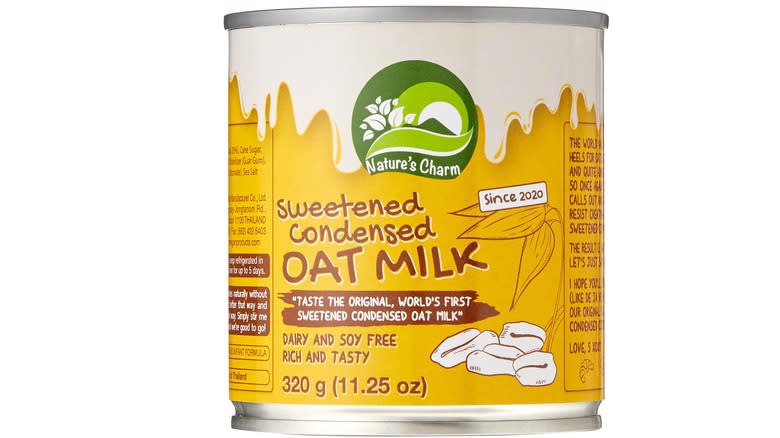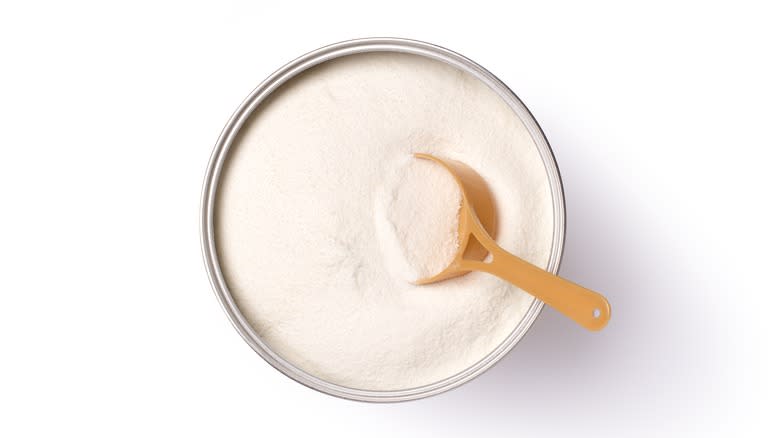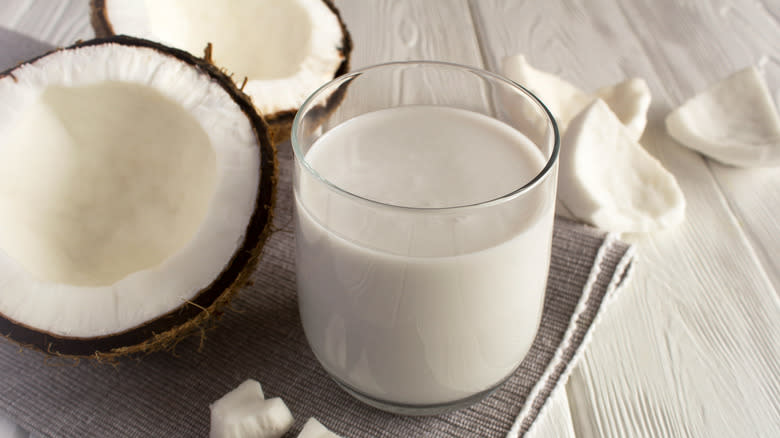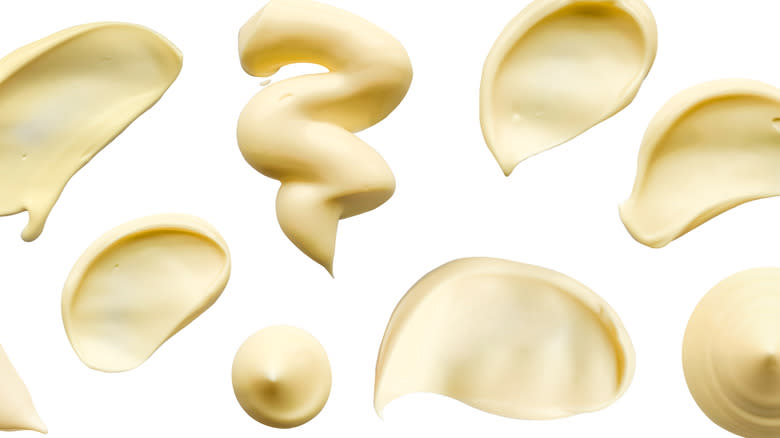7 Best Condensed Milk Substitutes For Baking, According To A Pastry Professional

We may receive a commission on purchases made from links.
What do blondies, fudge, and millionaire's shortbread all have in common? Each of these baked goods are often made with condensed milk, a unique ingredient that lends a toasty, caramel-like flavor to many of the world's favorite desserts. As delicious as condensed milk is, however, circumstances often demand finding an appropriate substitute. Perhaps you have unwittingly eaten an entire can of condensed milk, spoonful by spoonful, before it ever reached the mixing bowl. Or perhaps you have a dietary restriction and are looking for a vegan alternative.
When substituting condensed milk, it helps to understand how this ingredient is made and why its flavor is so distinctive. Condensed milk is exactly what it sounds like: it is a concentrated form of cow's milk made by evaporating approximately 60% of the milk's water content and adding sugar. Its richness is integral to the texture of many desserts, like cheesecakes or recipes that call for dulce de leche, which is simply condensed milk that has been even further reduced.
I have compiled this guide of seven tried-and-true condensed milk alternatives for bakers of all skill levels, based on my experiences of baking at a bed and breakfast in North Carolina, as well as in my home kitchen in India. In both roles, I have frequently adapted recipes to accommodate ingredient availability and to suit plant-based diets, and in doing so, I have tested many condensed milk alternatives. For more information on the selection process, please reference the end of this article.
Read more: 30 Types Of Cake, Explained
Homemade Condensed Milk

If you do not have any dietary restrictions and are simply here because you can't readily put your hands on a can of condensed milk, consider homemade condensed milk your best option. Although condensed milk first experienced widespread popularity in Western cuisines around the time it was commercialized in the mid-19th century, it's been used for longer. It can still be made at home using standard kitchen equipment, and the process is easier than you might think.
In fact, simmering milk on the stovetop is a low-maintenance and cost-effective alternative to purchasing condensed milk. It can take less than an hour to prepare and allows you to make a large quantity at once; as opposed to the 14oz cans available at the grocery store, making a batch of condensed milk at home can yield as large of a supply as you need, with the caveat that it must be used within a week or two if stored in the refrigerator or within a few months if stored in the freezer. Check out this recipe for sweetened condensed milk to get started.
Evaporated Milk

Evaporated milk is similar to condensed milk, but without the added sugar. After homemade condensed milk, evaporated milk is likely the best alternative for most baked good recipes. Evaporated milk can be substituted for condensed milk using a 1:1 ratio; the texture will remain virtually the same as condensed milk if you add granulated sugar, and it will become marginally thinner if you use it straight from the can.
For those looking to reduce their sugar intake, evaporated milk can be used without modification, particularly in recipes like brownies, in which sugar does not affect the dessert's texture as much and is already present from other sources. If desired, however, you can boil evaporated milk with an equal amount of sugar for just a few minutes. You can even experiment with adding your favorite unrefined sweeteners, like maple syrup or agave nectar, but note that this will affect texture.
With the addition of a sweetener, evaporated milk is ideal for recipes like flan and this easy tres leches cake recipe, in which condensed milk is a star ingredient and its flavors must therefore be closely mimicked. In such recipes, it is best to add sugar, lest the final product turn out bland. Adding sugar also helps achieve the light brown color of many desserts in which condensed milk is found, thanks to caramelization and the Maillard reaction.
Vegan Condensed Milk

Vegan condensed milk is another effective alternative that can mimic its dairy counterpart with surprising accuracy. Store bought versions are typically pre-sweetened and can be substituted using a 1:1 ratio. They are usually made using either an oat milk or coconut milk base, and the best option depends on dietary restrictions, personal preferences, and the recipe being followed. For instance, you might opt for Nature's Charm sweetened condensed oat milk for a more neutral flavor in desserts like brownies and cakes, while Nature's Charm sweetened condensed coconut milk might be the better choice for more tropical recipes like coconut macaroons, as well as recipes that require fat for textural reasons, like cheesecakes and pies.
One major con of store bought vegan condensed milk is the higher price tag. If this is a concern, you can also make a homemade version using soy, cashew, almond, coconut, or oat milk. The process and ingredients for each alternative milk vary, so be sure to follow a recipe if it is your first time making it.
Heavy Cream

You might have extra heavy cream on hand from the last time you topped a pie, or maybe you add it to your cup of coffee every morning. If so, you're already familiar with its thick consistency, so it should come as no surprise that it can be a fantastic alternative to condensed milk. This is largely due to its high fat content. Heavy cream is the concentrated layer that hangs out at the top of fresh milk, and it consists of 36 to 40% fat. This composition makes it ideal for making frostings and whipped creams, but, like condensed milk, it is also common to use heavy cream instead of milk for caramel sauces and ice creams. In many recipes, therefore, you can substitute heavy cream for condensed milk and hardly tell the difference in terms of taste or texture. Using heavy cream might even reduce the risk of your dessert curdling because of its high fat content.
Be sure to plan ahead because there is some prep work involved. After simmering heavy cream with granulated sugar in a 2:1 ratio until its volume has reduced by half, it can be substituted in your desserts using a 1:1 ratio. Note that you may need to add a few splashes of whole milk to reach your desired consistency.
Milk Powder, Dairy Or Non-Dairy

Milk powder was another 19th century revolution in commercialized, shelf-stable food products that transformed baking. Considerably cheaper than fresh milk, milk powder can be safely stored for up to a decade or more. Even if you don't enjoy drinking reconstituted milk powder on its own, it can be an effective substitute for condensed milk, especially given the flexibility you have when rehydrating it. You can even brown milk powder with butter before reconstituting it to draw out more complex flavors.
Non-dairy powders, like soy milk powder, are also suitable for this style of substitution. In both versions, you should add sugar, as well as oil, margarine, or butter to make up for the fat lost through dehydration. As a general rule of thumb, add boiling water until you reach the right consistency: more syrupy and less pourable (milk powder is sold in varying densities, and so the amount of water required will vary). With experience, however, you can learn to adjust your water to powder ratio according to the recipe at hand. Need a substitute for condensed milk in a hot fudge sauce? Leave it more syrupy by adding less water. Incorporating it in a cake or brownie recipe that always turns out too dry? Add more water.
Full Fat Coconut Milk

Full fat coconut milk is made by blending water with the white flesh found lining the inside of a mature coconut. It is a common vegan substitute for condensed milk that, after simmering with sugar on the stovetop for 30-60 minutes, can be used in a 1:1 ratio. Even though this alternative requires only two ingredients, results can vary depending on the brand of coconut milk you purchase. Selecting a coconut milk that includes a thickening agent like guar gum may help your baked goods bind more effectively.
There's a range in quality between the most popular canned coconut milk brands. However, do not, under any circumstances, attempt to use a coconut milk beverage. It's often found in the refrigerated section alongside cartons of almond and soy milk. It is far too watered down to be used as a condensed milk alternative.
Using full fat coconut milk as an alternative to condensed milk might be perfect for a recipe like key lime pie, in which the coconut flavor would be a welcome addition. Avoid using it, though, in recipes like apple pie, where coconut would easily overwhelm and mask the taste of other ingredients.
Coconut Cream Or Cream Of Coconut

Like coconut milk, coconut cream is a blended mixture of coconut flesh and water. However, coconut cream has much more flesh than coconut milk, meaning it also has more fat. This additional fat makes coconut cream extremely thick and enables it to be substituted for condensed milk in a 1:1 ratio without any simmering required. This expedited substitution process can make coconut cream well worth the extra bucks you are required to pay per can.
Before opening your wallet, though, consider whether you want to buy coconut cream or cream of coconut. Although their names are similar, there is a significant difference between coconut cream and cream of coconut. Cream of coconut, which you may have seen sold by brands including Coco Reàl, Coco López, and Goya, is sweetened, while coconut cream is not. They may even be found in separate sections of the grocery store; cream of coconut is often shelved alongside bartending ingredients, while coconut cream is frequently housed in the international aisle.
The best choice between the two depends on flavor preferences and the necessity of sugar in the recipe. For instance, when fruits and/or sugar are already present, such as in a recipe for banana bread, coconut cream could be the better option. Again, be mindful of which recipes would be complemented by a strong coconut flavor and which recipes would suffer. If you think your recipe falls into the latter category, choose a different alternative.
Methodology

I selected these options as the best condensed milk alternatives primarily based on how similarly they impact the texture and flavor of recipes; the ultimate goal, of course, is to mimic condensed milk as closely as possible so that nobody will guess a substitution was made. Because we live in a world where time is a luxury, I also took into consideration each substitution's price tag and preparation time. Color was a tertiary concern and not a key criterion for this list, although some bakers will prioritize it, particularly in recipes that traditionally appear brown. If you need to satisfy that requirement, I recommend using one of the first three alternatives: preparing homemade condensed milk, adding sugar to a can of evaporated milk, or using a store bought tin of vegan condensed milk.
I made these selections largely based on my own experience, but I also delved into the expertise shared by authors of food blogs and recipes, as well as the online discussion sparked by both in their respective comment sections. The "best" choice will always partly depend on the recipe in which the substitution is being made, so don't hesitate to follow your instincts, experiment, and report back with your results!
Read the original article on Tasting Table


